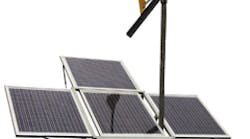I magine your city has been devastated by a hurricane, flood, earthquake, or tornado. Phone and power lines are down, water mains are broken, and hundreds of homes have been destroyed. Over the next few days and weeks, clean drinking water and emergency electricity could mean the difference between life and death. How can you obtain these potentially life-saving commodities in the midst of a catastrophe?
The answer to this question may be the Solar Cube, a collaborative effort by Spectra WaterMakers, San Rafael, Calif., and Switzerland-based Trunz. Designed to provide relief to communities affected by natural disasters, the Solar Cube is powered by sunlight and wind. According to the two companies, the system can supply 1,000 gallons of drinkable water from a saltwater source and up to 3,500 gallons of clean drinking water per day from a polluted freshwater source, including rivers, creeks, and wells. Moreover, the Solar Cube can generate enough energy for disaster officials to power refrigeration for emergency medical supplies, keep a laptop online, or charge a cell phone. Depending on the solar and wind conditions, excess electricity to run emergency equipment is approximately 1,200W.
“The product has been in the making for approximately three years, but only became commercially available last year,” says Rick Wood, marketing director for Spectra WaterMakers. “These units would have worked very nicely during the devastating hurricane season a few years ago because they are able to clean up the water for drinking as opposed to trucking or flying in bottled water by helicopter.”
Portable and self-contained, the Solar Cube operates by storing energy from the sun via photovoltaic solar panels — or from wind by means of a wind generator — into a bank of built-in 24V batteries. The batteries send power to the water delivery pump and the pre-filtration system to remove large matter. Next, the water is run through the reverse osmosis desalinization module, which purifies the water by eliminating bacteria, viruses, salt, and chemicals. If the water is contaminated with oil, an oil-water separator or an oil pre-filter can be added to the unit as needed.
According to Spectra and Trunz, the Solar Cube can be erected in less than one hour. Once assembled, the system is straightforward to operate, cleans its own filters, and has a reported service life of at least seven years. A portable water tester is included with the system, which tests the total dissolved solids (TDS) to ensure the water is drinkable. In the event of limited wind and/or sun, the unit will run on the energy that is stored in the batteries, or it can be plugged into the grid or a portable generator.
In addition to affording relief from natural disasters, the Solar Cube can provide water and electricity to inaccessible locations or for developers working in rural areas. “The Solar Cube is also for applications in homes or buildings located off the grid,” says Wood. “It's designed to operate in extreme conditions, and its components are marine-grade.”
Lin Sharwood, CEO and president international of Global Life Water, Karachi, Pakistan, attests to the product's rugged construction. “In harsh conditions, it has survived blizzards and searing sun,” she says.
For the past year and a half, Global Life Water has operated and maintained three of the water purification units in Pakistan. “The Solar Cube delivers a large volume of pure drinking water with no energy cost, ongoing fuel costs, or environmental damage,” Sharwood continues. “It doesn't need any tools, cranes, or forklifts to be set up — a pickup truck is all that is required to get it to its location.”
Sharwood goes on to say that the additional electricity generated by the units allows villagers to power light bulbs to read; cell phones and computers to communicate; oxygen generators for the sick and elderly; and provides medical clinics with basics such as sterilization and refrigeration.
Available in three models, pricing for the Solar Cube ranges from $38,000 to $80,000, which includes training. For more information, visit www.spectrawatermakers.com or www.trunz.ch.




